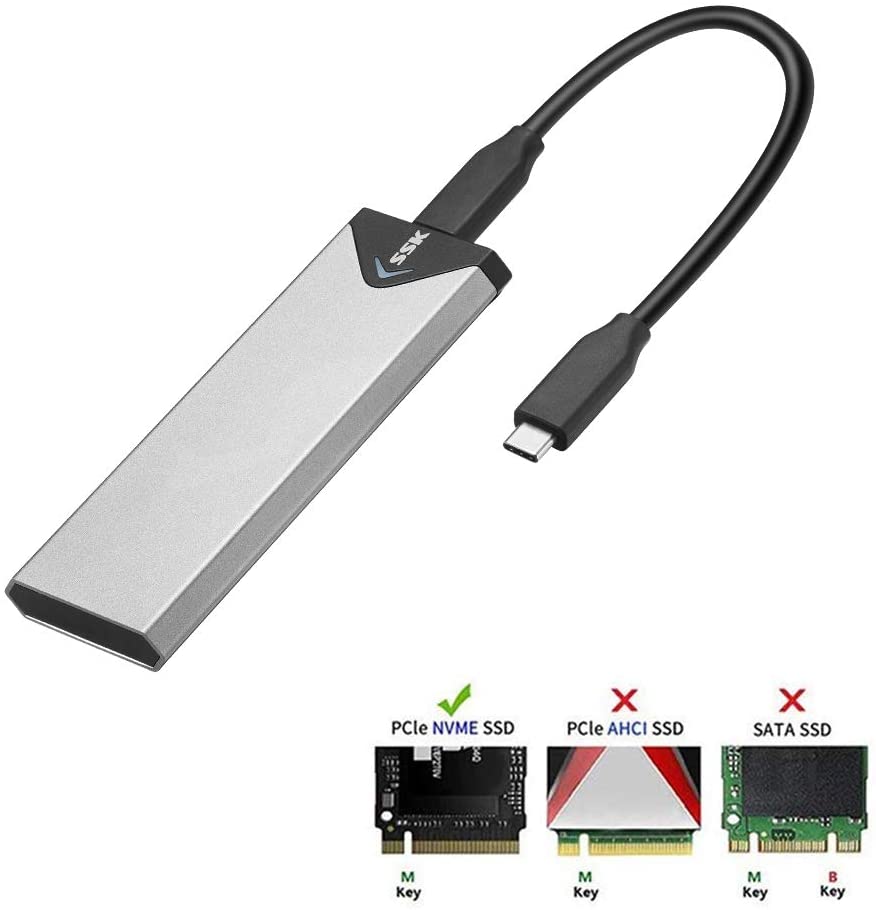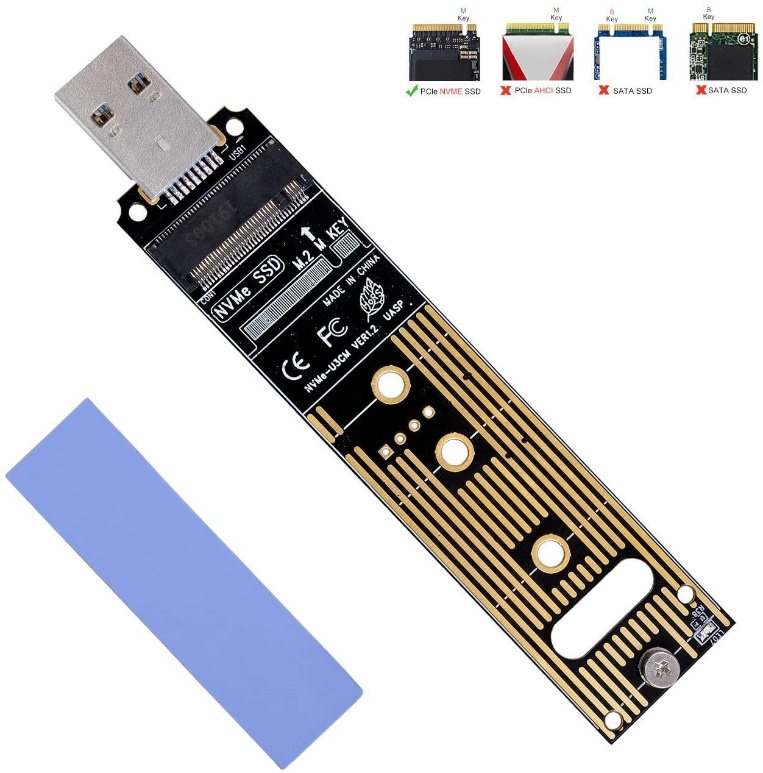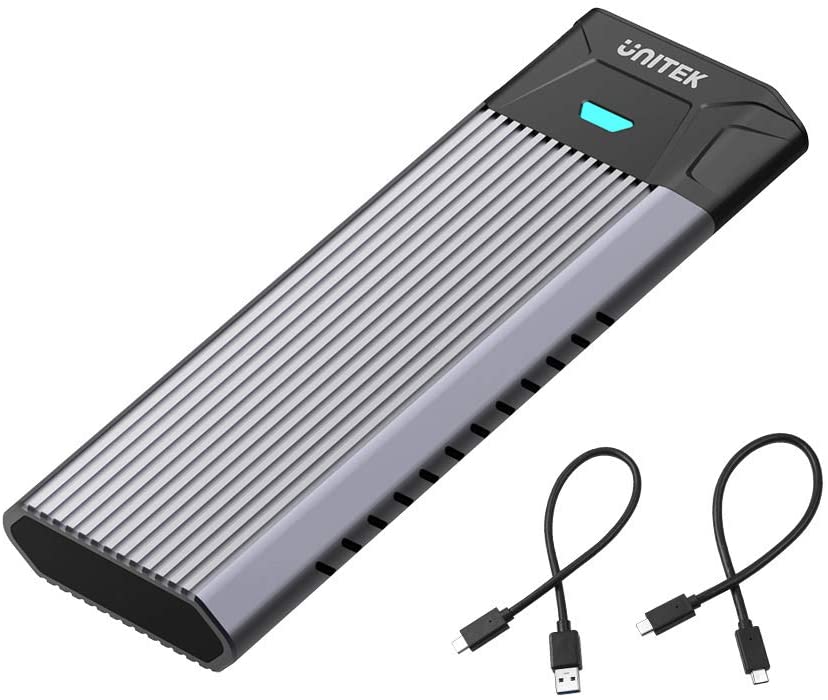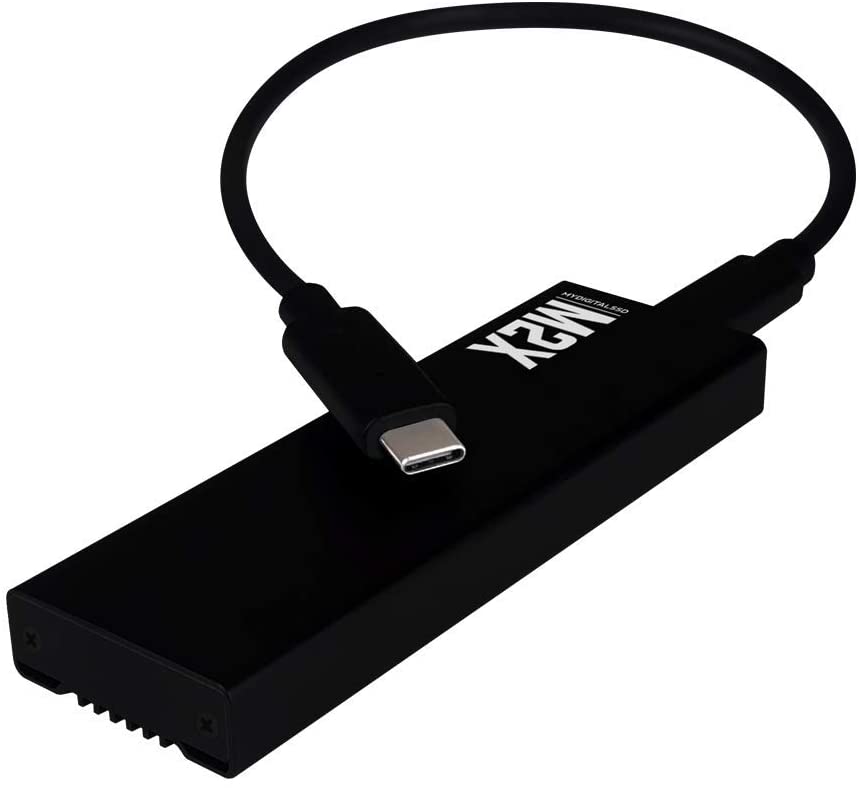In this article, we review the top five NVME to USB adapters. Later on, we discuss the essential factors to keep in mind when hunting for the right choice. So, let’s begin!
1. SSK M.2 NVME SSD Enclosure Adapter

This compact M.2 NVME SSD Enclosure for PCIe SSDs is a portable, high-performance data storage solution for your USB 3.1 (second generation) or Thunderbolt 3 enabled devices. Thanks to its high-performance controller chip (JMS583), the data transmission rates reach an astounding 10 Gbps (1000Mbps R&W speed).
The aluminum build is decent. It is plug & play and supports hot-swapping. Besides, it has a straightforward installation process. You just need the tiny screwdriver (included in the package) to insert the SSD into its PCIe NVME Slot. Great! Now plug it into the USB port and start cloning right away.
When closed, the SSD cardholder presses the drive against the metal casing to improve cooling. Moreover, the kit comes with a thermal pad. You can stick it onto the SSD controller to further improve conduction. This helps keep the temperature in check. Plus, it offers multi-OS support (windows, Linux, MAC.
Our only disappointment is that the package includes a USB-C cable and no USB-C to USB-A cable. Even though USB-C is superior, older systems do not have a USB-C port, and having a cable adapter would have certainly been helpful. Overall, this is a solid premium item for a no-frills price.
Buy Here: Amazon
2. JESOT NVME to USB Adapter

Don’t want a wired NVME to USB adapter? Try JESOT’s M.2 SSD to USB 3.1 adapter. It has a straight connection and can also use it as a portable SSD. Based on the JMS583 chip, it is more stable and Widely compatible with PCI-E (M-KEY) Interface.
It’s a plug and play device. Simply snap it in. Then tighten the included screws. Plug it into a computer, and then format to your liking. Done! However, keep in mind that it ONLY supports PCIe NVME based M Key & B+M Key SSDs. It doesn’t support any SATA-based SSD.
Theoretically, the device can achieve a transmission speed of 10Gbps. Nevertheless, our quick speed test got 7.5Gbps, which is not bad at all for higher speeds. However, you should consider investing in a fully enclosed adapter. One advantage of no enclosure is that it offers faster heat dissipation. So you can read/write for longer periods without worrying about the rising temperature.
It’s a blue LED that is super useful. Stable when the adapter is online and starts blinking when active. You can easily see when the cloning is done (the light stops blinking). Unfortunately, it is compatible with Windows and MAC only. That said, JESOT’s NVME to USB adapter delivers what it promises – excellent performance. Highly recommended for cloning NVME drives if you are on a budget.
Buy Here: Amazon
3. Unitek M.2 NVME SSD Enclosure

Unitek’s M.2 NVME SSD enclosure adapter is lightweight, portable, and compact. So you can take it along. The aluminum alloy design gives it a solid feel but do not drop it, please. The enclosure comes equipped with the RTL 9210 controller chipset and offers 10Gbps ultra-high-speed transmissions. What’s more, it supports forward and backward insertion.
The casing slides off easily, revealing the NVME SSD. It is held in place by a tension-loaded plastic clip. No screws or tools are necessary to install your M.2. There’s also a thermal pad and a metal strip for quick heat transfer. Perhaps that is why its heat dissipation is excellent. Personally, I don’t like to Perma attach the thermal pads, but it still works well to slide the pad and metal strip over the SSD drive. You can then slide the plastic cover back, snugly closing it.
The adopter offers a range of M-Key M.2 SSD compatibility. However, it wouldn’t work with mSATA SSDs, M.2 PCIe AHCI SSDs, M.2 SATA SSDs, none-M.2 form factor SSDs and M.2 PCIe devices like WiFi and capture cards.
All in all, Unitek’s NVME enclosure is an exciting option. It is compact, plug and play supports hot-swap, and offers up to 10Gbps (theoretical) speed. Plus, it offers a range of M-Key. In our opinion, a higher price and no Linux support are its main disadvantages.
Buy Here: Amazon
4. QNINE NVME to USB Adapter [Upgraded]
The QNINE’s NVME to USB enclosure is an interesting low-cost option. Based on the JMS583 USB3.1 Gen2 to PCIe Gen3 x2 bridge chip, it works fast with transmission speeds reaching 10Gbps. Compact & convenient, it has a travel-ready design as you don’t need a cable to connect with a PC or laptop.
The adapter is straightforward to set up. Instead of a mechanical snap, though, it uses a small screw to hold down the SSD. The package includes a magnetic screwdriver to help with that. Nevertheless, this can be a problem for people who are used to plug and play devices. The upgraded design comes with three thermal pads for cooling. Besides, it has an open design. Still, the device gets hot when you are transferring 500+ Gb of data or using it for longer periods.
Unfortunately, it doesn’t work with Samsung Cloning software. So if you are trying to clone to a new Samsung SSD, try Macrium Reflect to clone (or any other cloning software) and then some partition manager like EaseUs to get around this problem.
Overall, the QNINE’s adapter works great on Single Board Computers (Like Raspberry Pi) as an OS Drive or as a portable Linux OS Drive for rescuing dying drives.
Buy Here: Amazon
5. MyDigitalSSD M2X Portable SSD External Enclosure Adapter

On the fifth spot, we have MyDigitalSSD’s portable adapter. It makes you bring ultra-fast USB 3.1 NVME speeds on the go by turning any M-key SSD into a pocket drive.
The durable aluminum enclosure has USB-A & USB-C connectivity and provides up to 2TB data storage capacity. All thanks to a grooved fin heatsink design, which reduces any overheating and thermal throttling. This also makes for much smoother data transfers. So, your drive achieves peak performance without any problem.
What’s more, the M2X enclosure adapter is plug and play. It’s compatible with 2280, 2260, & 2242 form factors, compatible with all OS and fully bus-powered for multiple uses.
That said, its hardware does feel cheap and clumsy. However, that’s hardly a concern because this enclosure adapter works with lightning-fast speed and is an overall Great external drive case. Plus, it comes with a one-year manufacturer warranty to cover your back if something goes wrong.
Buy Here: Amazon
Buyer’s Guide
Choosing the best NVME to USB adapter isn’t just in your interest. It makes sure your drive stays protected too. A suitable drive will ensure full compatibility and help you remove any bottlenecks within your build that may pop up in the future. So read this buyer’s guide carefully!
Size support
M.2 NVME’s come in multiple sizes. Most commonly 2242, 2260, 2280, and 22110. So choose an enclosure that supports your disk size. Please note that these enclosures don’t support all sizes. The information is usually written in the product description.
Transfer speeds
The sequential read and write speed is just as crucial as the random read and write speed. You should select an adapter which has a nice balance of both. All the products mentioned above have theoretically 10Gbps sequential RW speed while the random RW speed differs depending on the model.
Casing
No casing means the adapter will easily dissipate heat during the large file transfers. But such enclosures are hard to maintain. If you purchase one with an aluminum casing, make sure it is durable and heat tolerant enough to work without throttling the transfer speed.
Temperature
To keep the temperature in check, the best NVME to USB adapter uses extra thermal pads. These are sometimes included in the package. If not, you can purchase extra pads online. Apply the pads to both the top and bottom of the drive to help with heat dissipation.
Connectivity/Compatibility
The products mentioned above are all compatible with USB 3.1 Gen 2. In case you often work with USB 3.0 or 2.0, make sure the drive is backward compatible. Some adapters will only work with USB 3.1 or USB 3.0, which limits their applications.
Price
And of course, you have to keep the cost in mind. If you don’t want extra bells and whistles, a basic enclosure with decent enough speed will cost around 25 bucks. Higher-end models can be as expensive as $100.
Final Thoughts
The best NVME to USB adapter can be used in more than one way. It can turn into your high-speed storage, or you can utilize it for cloning an existing drive, backing up data, running a mobile OS, and much more. We hope you got to learn a thing or two from this article. If you have any comments let us know. That’s all for now. Good luck!
from Linux Hint https://ift.tt/3lqoIrs




0 Comments